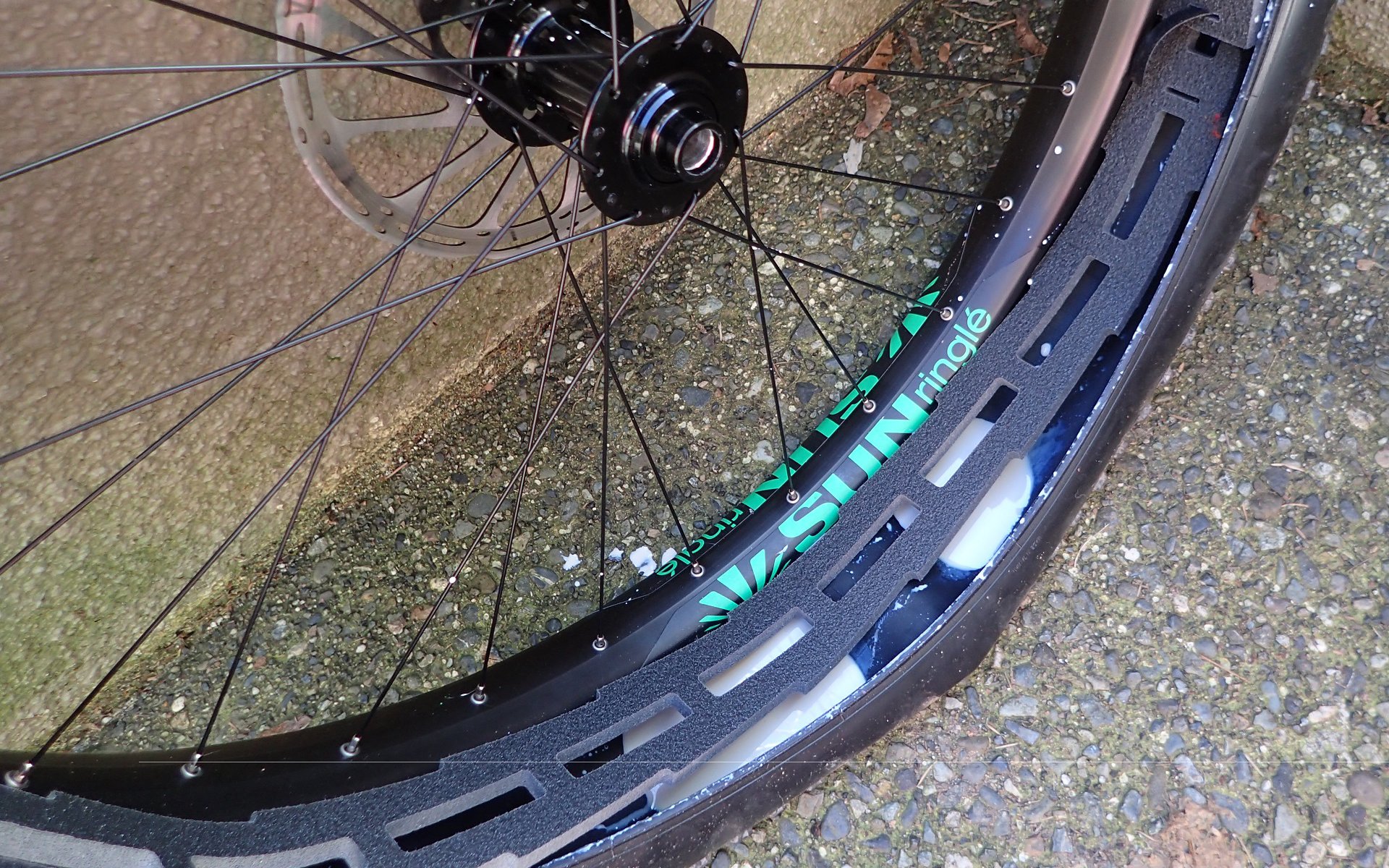
Editorial
Are Tire Inserts a Solution or a Band-Aid?
Tire inserts have taken segments of the mountain bike world by storm. Only a few years ago puncture and rim protection solutions were few. In most cases, the approach was to run a heavier casing tire and/or bump up air pressure and sealant volume. ProCore was available at that point but, despite a lot of hype, it didn't take off.
Then Aaron Gwin showed up backing Flat Tire Defender, a tubular shaped foam insert. Prior to the official release, some keen eyes got a glimpse of it when he flatted during his Val Di Sole World Champs run. Gwin had run the Flat Tire Defender system for the entire 2016 World Cup season, and ended up winning the overall.
But before FTD was released, Huck Norris arrived with a simple insert. And while it was the first of the latest wave to the party, it offered fewer features. FTD claimed to improve ride quality while Huck Norris only provided what was written on the packaging; pinch-flat and rim damage prevention. Then came CushCore with bolder claims than FTD. CushCore is marketed as a tire suspension system and for many, it has lived up to the claim.
Now more than two years since these inserts first saw the light of day, they’ve led to the latest craze of mountain bike business ventures. Many inserts are now available and more continue to show up, aiming to improve on what's available or offer something new.

CushCore on the left clearly fills the rim-bed and supports the sidewall where the Huck Norris, right, only works for pinch-flat prevention. It's lighter though…
Riders Against Pinch-Flats
We’ve all experienced it. You drop into your favourite section of trail, get a bit too creative and hear the awful hiss of air escaping your tire. It's one of the worst sounds ever and it’s something riders have dealt with for decades. Tires have improved enormously in that time but so have bikes. It’s not uncommon to see trail bikes shoed with DH treads. The heavyweight tires help prevent flats but they're no perfect solution.
Every tire insert on the market claims to help prevent pinch-flats. For an extra ~70–250g/tire you can roll with extra assurance you’ll get to the bottom with air in your tires. As with DH tires, these aren't perfect but in many cases, they are helping. And yet I have seen an EWS racer flat and cause significant rim damage with two of a particular insert doubled up in a single rear tire. Obviously some impacts are too much for any solution and there’s no protection from a slice through the tire with the options I've mentioned above.*
*Tannus is an exception
Some riders prefer the ride quality of a thicker tire casing, which provides a more damped, stable ride and in choppy, rough terrain can hold a line better. A thinner casing has a tendency to skip about, deflecting off obstacles in the trail. For some, it’s about more than flat prevention so is it worth their extra hard earned cash to get a similar feel? The addition of an insert can improve these qualities to riders already using heavy duty tire setups.
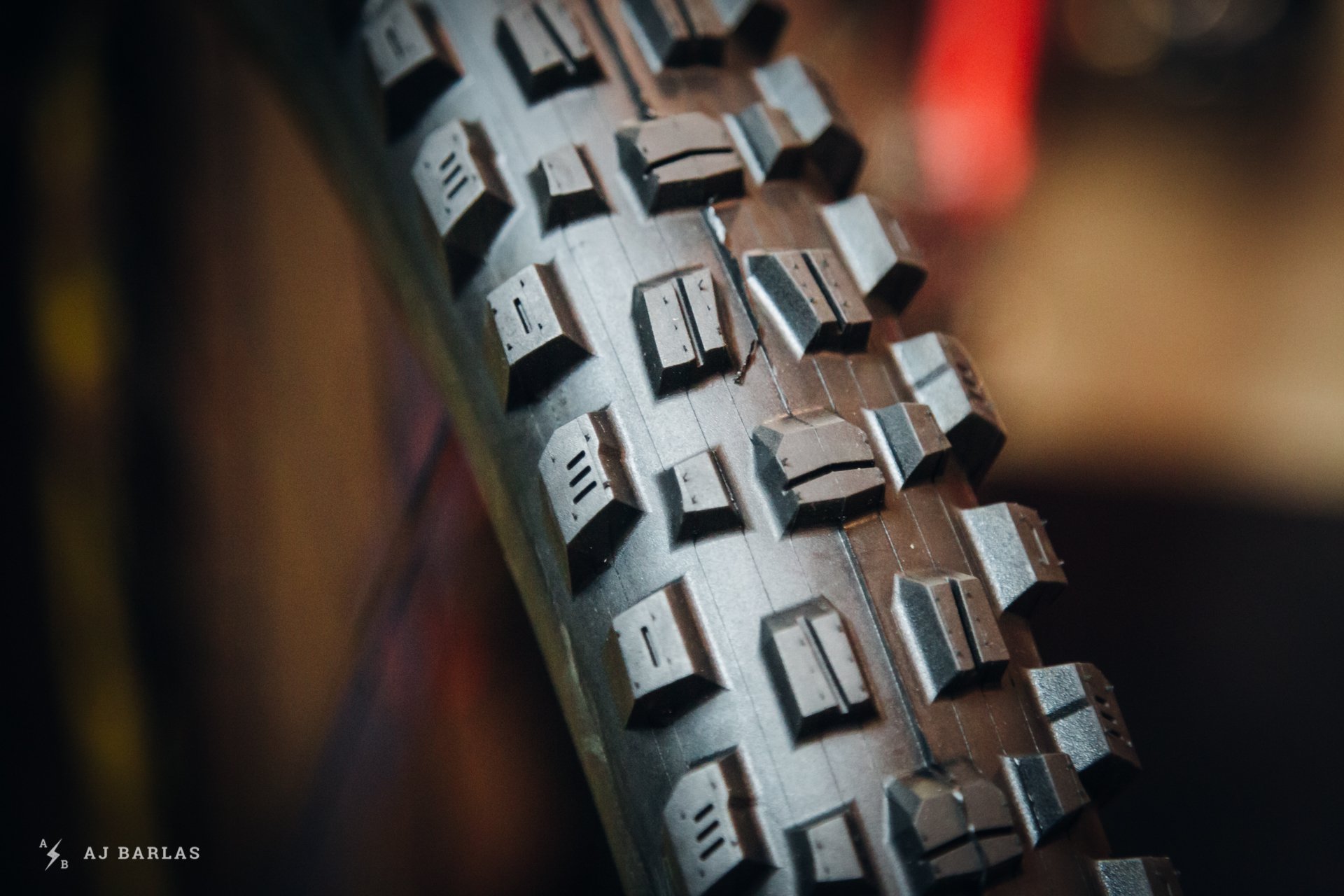
DH tires weigh more than trail tires but provide greater flat prevention and a more damped ride quality. Does a trail tire with an insert, one that adds support like CushCore, function better? Or Tannus that can actually protect you in the event of a ripped or punctured tire? Photo: AJ Barlas
Is something missing from current tires? Downhill racers struggling with flats are likely to say yes and while an insert won’t guarantee a flat-free run, it improves the odds. Enduro racers are in a more awkward place. They could run DH casings but there aren't any guarantees, so an insert may be required for added security. Running a lighter tire casing at the elite level is likely ill-advised but perhaps an added insert can bridge the gap. And EWS riders have to pedal that weight up to the start line in many cases making extra grams a concern.
For trail riders seeking only flat and rim protection, is an insert better than putting a burlier tire on? A tire insert could be evidence that they’re running the wrong tire, air pressure, or suspension setup for their riding.
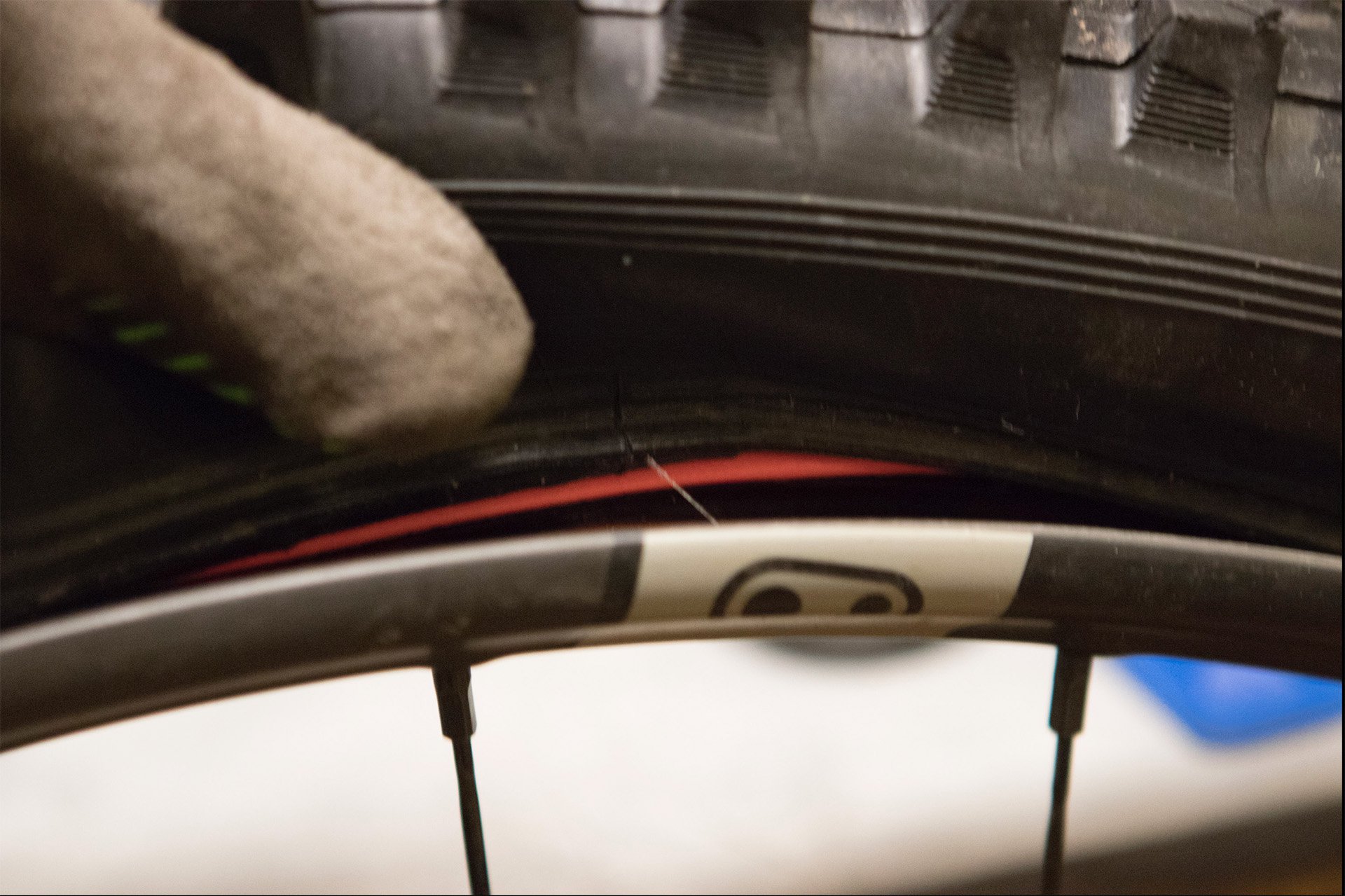
Tannus Armor is a new name in mountain bike inserts with another take on the system. Do the ride qualities they provide work better than running a more aggressive tire? Photo: Cam McRae
Carbon Wheels
Despite their expensive price tag, carbon rims have become increasingly popular. I reckon I see more carbon than alloy rims during any given trail ride at home, which is pretty wild. Their cost hasn’t made them unbreakable though and a little extra weight from an insert, is good insurance to many.
But if protecting the expensive carbon rim is the main reason a rider opts to run an insert, maybe carbon is the wrong material for the rim to begin with. Alloy wheels have been around forever and while a ding large enough to ruin a tire seal sucks, the cost of a replacement is palatable and a rim with some give is less likely to flat.
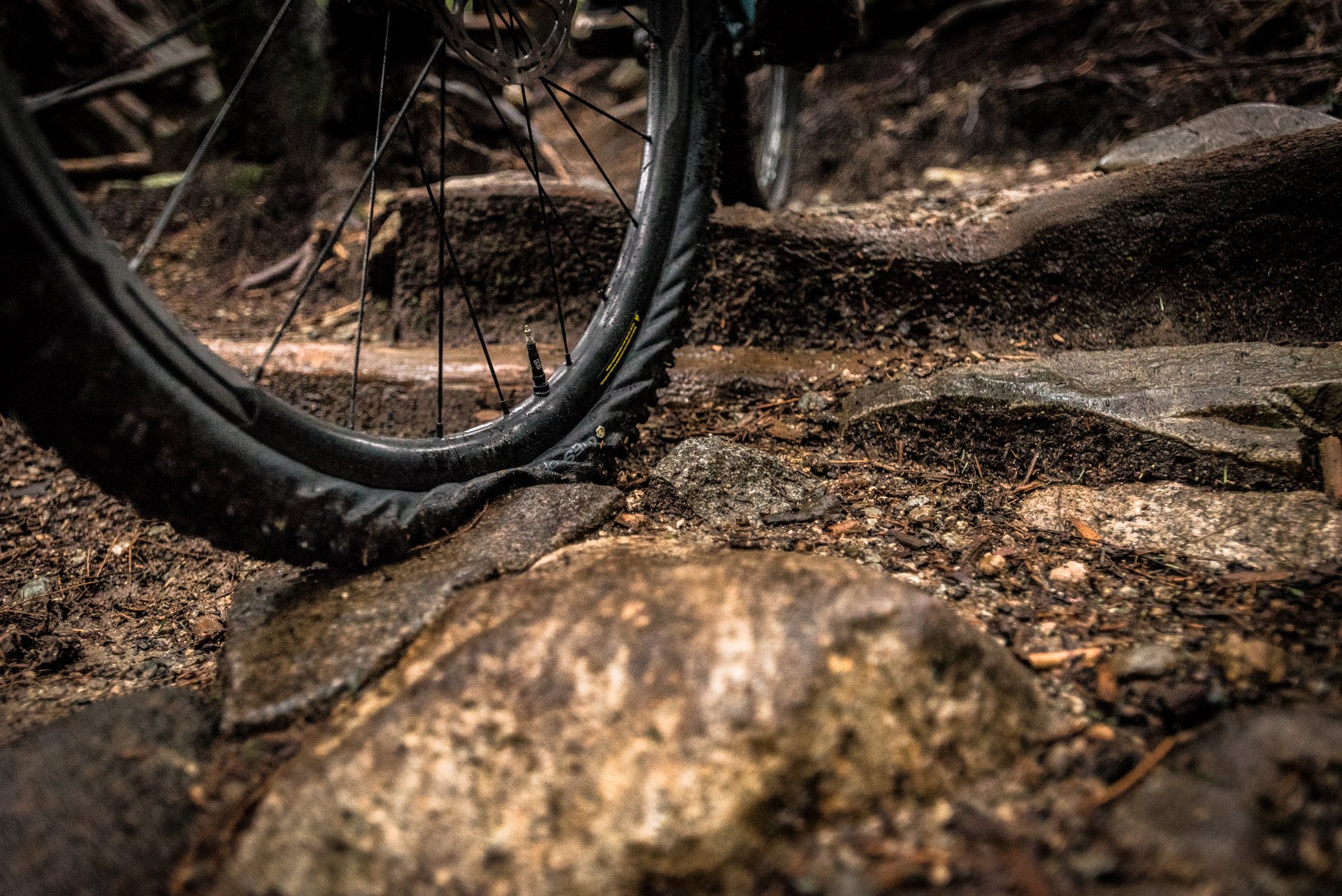
CushCore inserts hide beneath a squirming tire and an expensive carbon wheel. Photo: Dave Smith
With the advent of carbon rims, we’ve seen wheels that stay in shape longer, despite taking the same size hits. Carbon wheels remain stiffer than alloy when an obstacle is encountered especially at the bead, and the characteristics of the material don’t allow it to ding. While this is challenging to prove, more riders on carbon wheels could mean more pinch flats. Where alloy would give, carbon keeps its shape and the tire is subjected to higher forces. Maybe this was the opening insert manufacturers needed.
Currently Enve is the only rim brand with a solution. The Dynamic Impact Design is the lightest, simplest system for pinch flat and rim damage prevention. A bonus is that it simplifies tire installation while inserts can create a world of frustration. And yet, if you’re looking for the tire suspension traits of some inserts, this isn’t it.
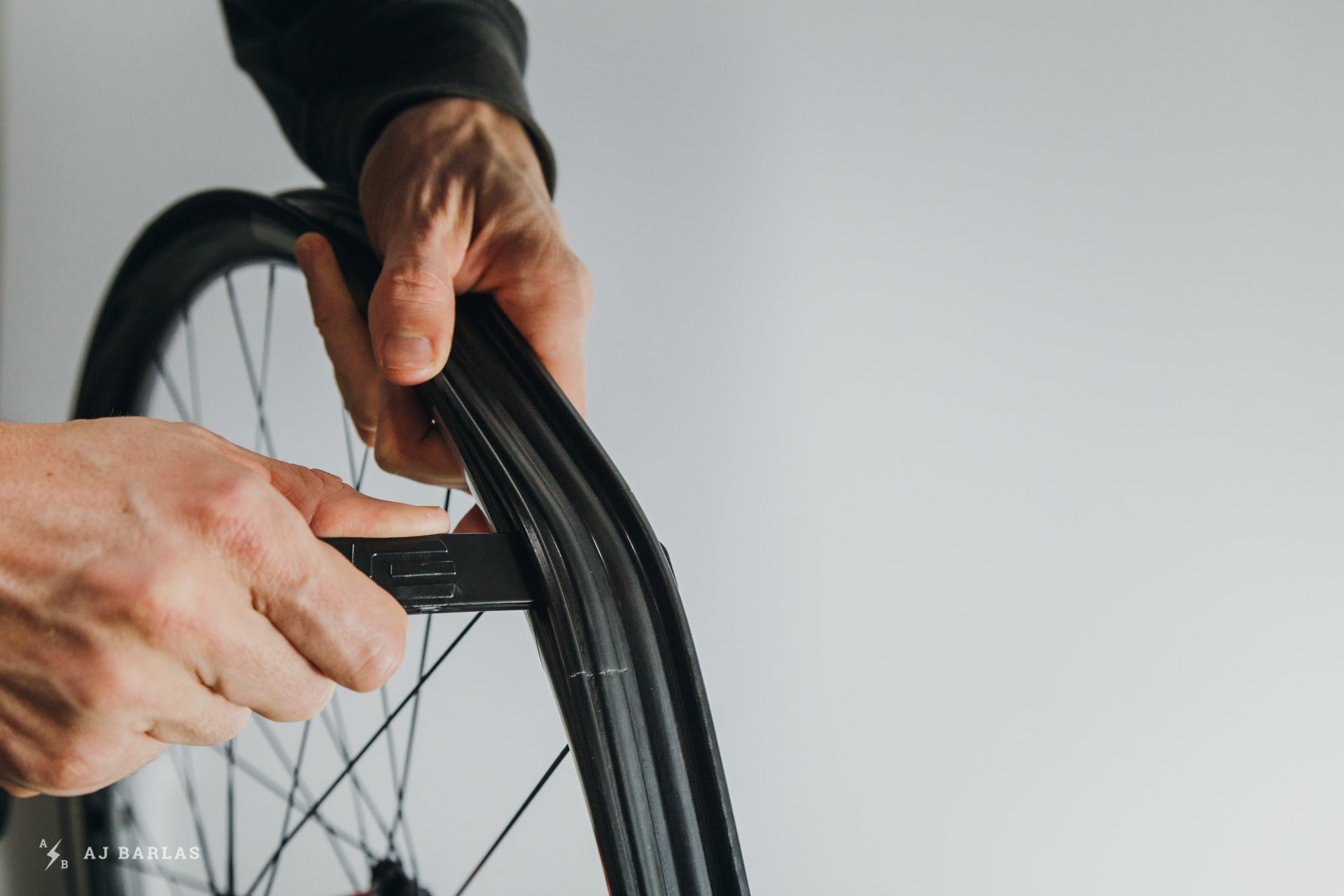
Enve's protective strip does a great job preventing flats and rim damage and it's part of the product. There's no tire support though. Photo: AJ Barlas
The Timing is Right
Tales exist of products that didn’t take off in every industry, and it's not uncommon for these to gain traction later on, sometimes with some refinements. The tire mousse insert concept isn’t new—it’s been around since at least 1984. If alloy wheels were an issue, wouldn’t we have seen this before now? I’m not saying that an insert can’t benefit a rider on an alloy wheel, but the timing of carbon wheels and the supporting elements have lined up perfectly.
The combination of mountain bikes growing increasingly popular, technology rapidly improving, and riders seeking more from their equipment could explain the tire insert craze. Add in the carbon wheel trend without major advances in tire construction and we have the ideal climate for tire inserts.
But we can’t forget that some insert manufacturers offer more than pinch-flat resistance and rim protection. Aside from Huck Norris and similar solutions, most of the inserts available offer a level of improved ride manners. The insert can dull vibrations from trail feedback, increasing comfort. Several also provide a more secure seal, preventing burping and allowing riders to really load up into corners and compressions. There’s also the opportunity to run lower tire pressures thanks to the supportive nature and secure bead afforded from inserts.
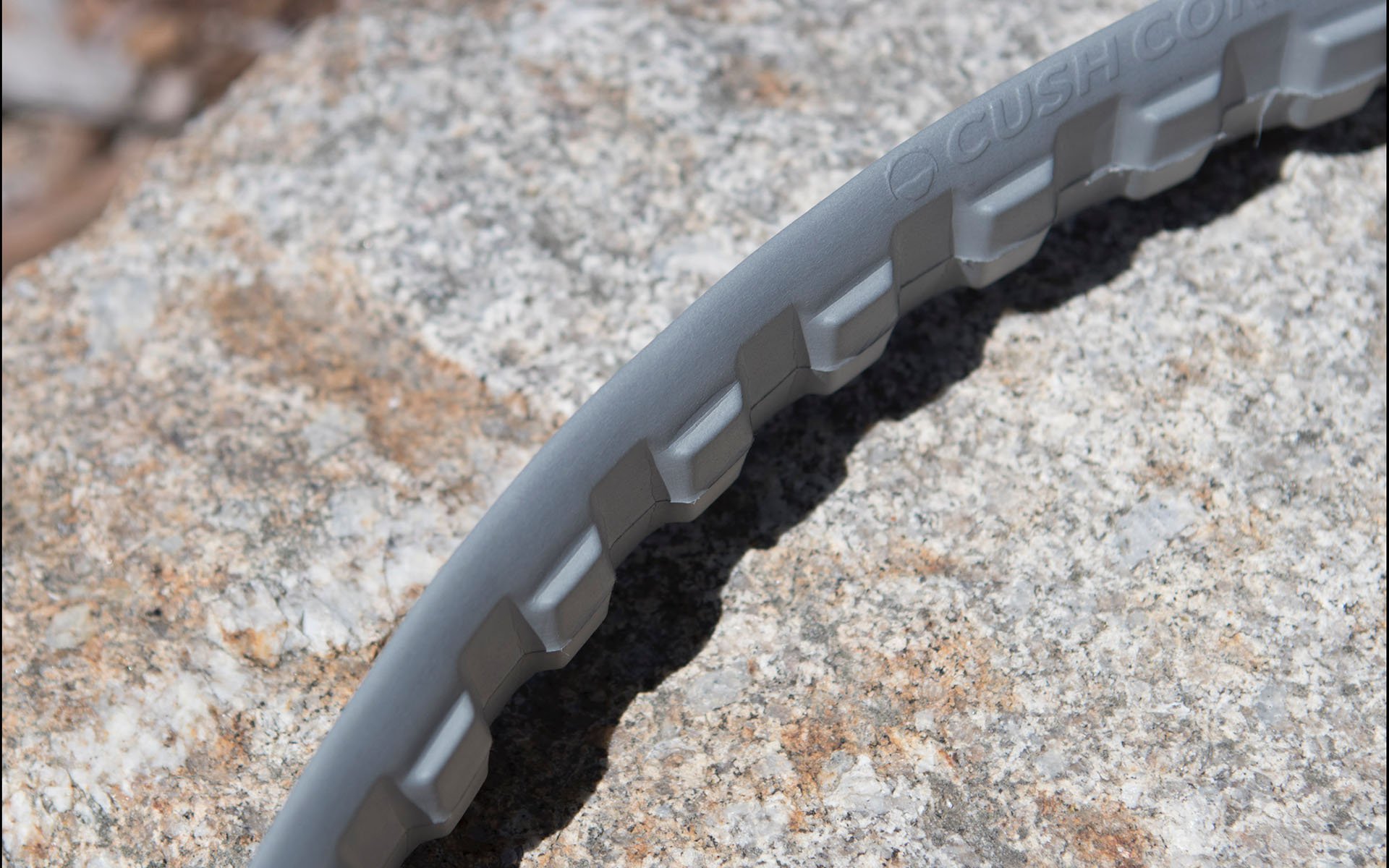
The new "CushCore XC" weighs in at a claimed 150 grams for a 29-inch wheel, a significant drop from their original insert which weighed 260 grams for the same wheelsize. The cost remains the same though; 149 USD for a set. Photo: Cam McRae
To benefit from inserts you need to accept a weight penalty and extra cost associated with adding another wear part to your bike. For some, it’s a no-brainer while for others, it’s harder to stomach. CushCore is aware of this and despite owner, Adam Krefting being apprehensive about producing a lighter solution, they’ve done so. The price is the same, and while a Maxxis DH tire can be bought for 80–95 USD, a similar tire in a lighter construction* plus inserts will cost around 146 USD. You need to really want that added security and support to spend more and you're still running a thinner layer between you and those sharp trail objects.
*Maxxis DHF DH and EXO tires
Are tire manufacturers going to update their products to incorporate the features offered by tire inserts? Do they need to? What about more wheel manufacturers following Enve and offering a protective strip? Do we want tires and rims to improve so there’s no need for inserts? Or should more riders pony up and run a DH tire instead? I just keep coming up with more questions… One thing is certain though; no-one ever complains about having plenty of options to fine tune their bike.
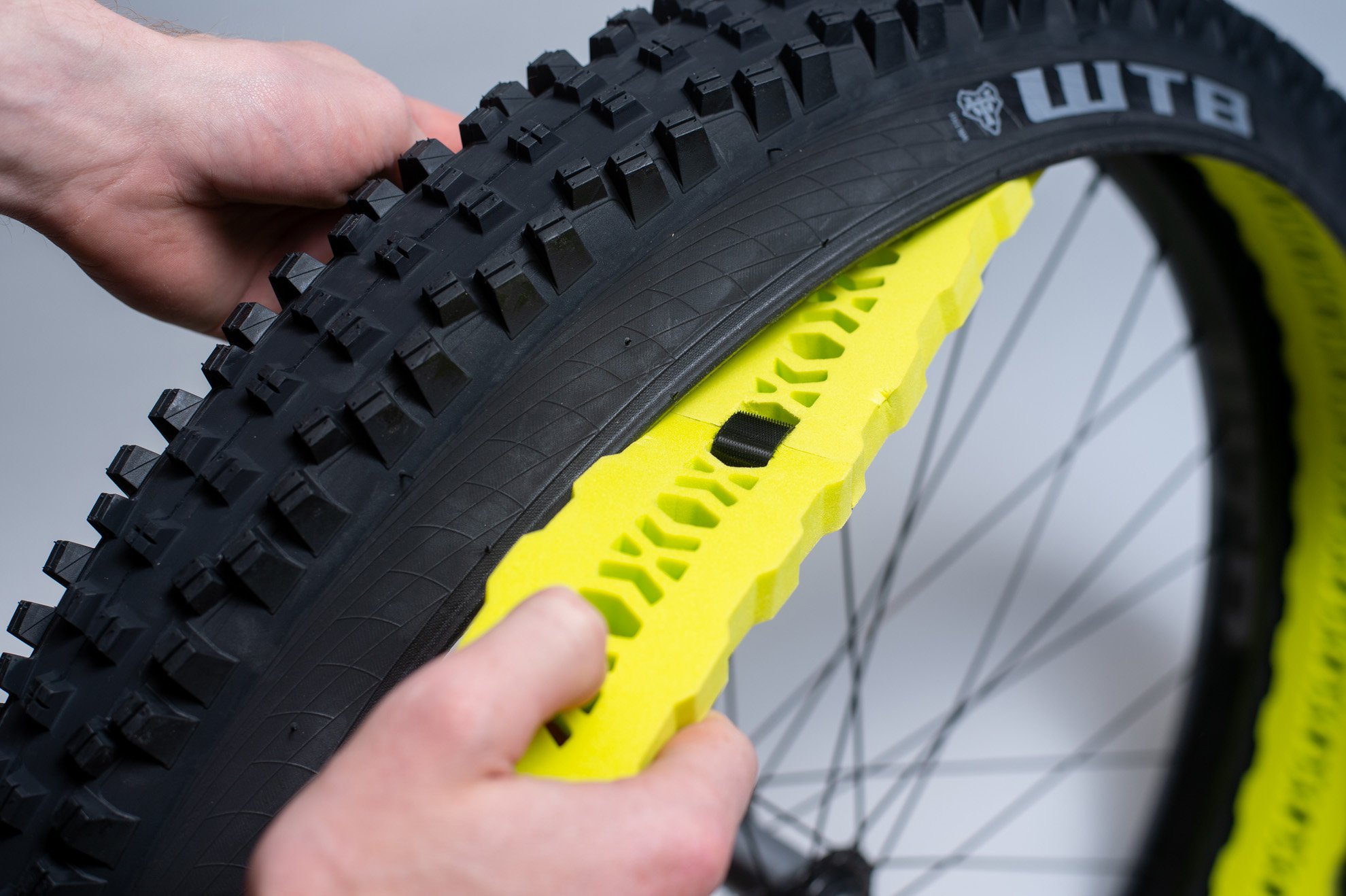
The latest insert to hit the market looks a lot like one of the first…
Depending on who you are and what you’re after, tire inserts are either a solution or a band-aid. In a racing situation they're almost certainly a necessity but it's not black and white and is likely still going to come down to personal preference. For me, the jury is still out but I plan to test more over the course of the summer, and I’ll be comparing them with burlier tires.
If you use tire inserts; what type do you use, what tires are they in, and what rim material do they surround? I’m curious to know more about why and how riders are using them, or why they aren’t.
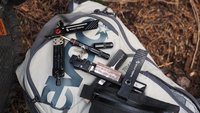

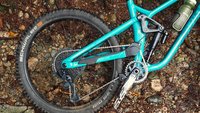

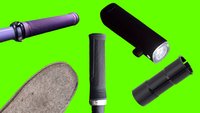


Comments
danielshiels
4 years, 8 months ago
I tried huck norris with an exo after smashing a rim, it did work in that regard and with snakebite punctures but not much else. I've since gone to dd casings front and rear and although I can feel the weight they seem to offer better damping and I can get the stickier compound for the front in dd as well. Can't really justify the extra weight of an insert as well but I've been thinking about a cushcore and exo in the rear so your idea of a review comparing ride quality between heavier tyres or inserts is a great idea.
Reply
Adam Grice
4 years, 8 months ago
There are probably better solutions than tire inserts, but one of their advantages is their compatibility. I can use nearly all of the inserts on the market on almost any rim/tire combo. I don't need to buy a special rim or a special tire or anything, I'm not stuck to one brand, and I have more options for customizing the ride quality that I want.
Reply
Luix
4 years, 8 months ago
I'm still wondering why the rim makers are using the same design originated in road racing, where the tire profile usually follows up the rim sides. Those things are designed to bring vertical support for a heavily inflated tire, while we on MTB use tires which balloon away from the rim. The proclaimed merit of the hookless sidewalls is another thing leaving me speechless. Why can't we think of a rim profile/bead hook combo that drives the impact forces laterally rather than vertically? Something resembling more of a "D" shape, rather than a "A" one. And make the sidewall end in a rounder shape, just like the dirt/MX bike rims do.
Reply
AJ Barlas
4 years, 8 months ago
Amazing! Just like geometry, tires and wheels need to be rethought for mtb and not be stuck with our roady influenced design backgrounds. Your idea for the profile makes a lot of sense. I wonder if there’s anyone able to comment further on a design profile similar to that and how it would work?
Bueller…?
Reply
Luix
4 years, 8 months ago
I have been fueling this debate on other sites, and while I understand lightness is always a top priority when pondered against strength in the MTB industry, I still believe the idea has some merit. The added support for the tire sidewalls when carving turns would just justify the changes, and we would also kiss good bye the snake bites.
Tire beads would certainly need to grow more bubbly in order to be hooked to the interior of the rim, but I don't think extruding the profile in aluminum would be any more difficult than with the existing profiles. We already have multi-chambered aluminum rims, such as Kore's latest creations.
Reply
slyfink
4 years, 8 months ago
What about Newmen rims out of Germany? They make aluminum rims whose walls are angled rather than vertical... The marketing claims is that they did this to better dissipate impacts to the rim while the bike is leaned over. https://www.newmen-components.de/en/77/mtb/rims/evolution-sl-a30/ I'd love to try a set. Weight seems reasonable too. If only they were available in Canada...
Reply
Niels van Kampenhout
4 years, 8 months ago
I've also heard good things about Newmen rims. According to their website, they have a Canadian distributor.
Reply
AJ Barlas
4 years, 8 months ago
I've been trying to source a set of those for review. Fingers crossed I can get in touch with the appropriate person. We'll let readers know if/when we get ahold of some.
Reply
badIuck
4 years, 4 months ago
Tell me how to get in contact with you and I'll happily get you sorted :)
Reply
Timer
4 years, 8 months ago
I have a pair of those (bought in Germany). Read some reviews and tests before purchasing and found nothing but high praise for the Newmen rims.
A magazine tested rims to destruction, and these were the toughest and lightest alu rims by far. Even tougher than several carbon rims and lighter than some carbon options too.
So far mine are good, but i haven't ridden them enough for a final verdict. One thing though, the rims might be tough but they don't protect the tyre any better than normal rims. I managed to pinch right through a sidewall and thread in one hit. Not a scratch on the rim.
Reply
Luix
4 years, 8 months ago
Good catch! although the walls are angled, but not the flanges. I'd like to see a tubular, angled flange edge.
EDIT: As Timer says, this won't do anything to prevent snake bites or pinch punctures.
Reply
fartymarty
4 years, 8 months ago
Maybe an integrated tyre / insert (like a tubular for road bikes) is the way forward. Then it could be designed as a system rather than parts.
Or go one step further and integrate the rim into the tyre / insert package. This would however require tyre and rim manufacturers to co-ooperate.
I'm lucky in that I can run Exo tyres without inserts where I ride however I do rub split tube (ghetto) tubeless and haven't had any pinch flats (touch wood) in the last 8 years despite lots of dents in my rear rim.
Reply
AJ Barlas
4 years, 8 months ago
Integrated would be amazing. An old mate once ran tubular tires on an xc bike and he swore the ride quality was incredibly. Changing a flat however, shitty. Dealing with glue and all of that saw him back on regular tires eventually.
Reply
nick bitar
4 years, 8 months ago
I am so @#$ing sick of flat tyres!
I’ve thrown out 5 $95 tyres over the last six weeks, ruined a race and spent SO long cleaning Stan Race Day off of my 2 bikes!
I’ve been running 2.6” tyres from 800 grams to 1200 grams and they all get slashed. Both on the side wall and on the tread. Plugs sometimes help but only until the next hole.
I ride in the centre of Australia. Hard pack trails with lots of sharp rocks. I don’t think that I’ve EVER worn out a rear tyre. But that’s ok, I can live with that but the flat streak that I’m currently on is going to cause me to loose it!
Ive just ordered a set of Huck Norris but know that they will only help with pinches.
Everyone gets the odd flat tyre around here but it’s getting to a point that my mates don’t even comment as they wait for me to shove in another tube and wipe as much white Stans off my pants as I can before we get to the bar! (Always an awkward look).
Help me!
Reply
Nouseforaname
4 years, 8 months ago
Run narrower tires.
Reply
taprider
4 years, 8 months ago
and narrower rims if most of your flats are from sidewall cuts
You could also go much narrower rims and use a Pepi's Rokline and still be lighter than your current rims without a liner
Pepi's would give you back the sidewall support you lost for going to a narrower rim
Reply
nick bitar
4 years, 8 months ago
There's a 2.35 DHF in the shed, perhaps I'll throw it on. I do like the fat ones on my hardtail... I am talking about tyres still.
Reply
Vik Banerjee
4 years, 8 months ago
My carbon rims have proven stronger and more damage resistant than my AL rims. So I wouldn't run an insert to protect them where I would be fine with an AL rim. It would be the other way around.
Reply
Tim Coleman
4 years, 8 months ago
I have the same experience. I would usually go through 2-3 aluminium rims a year on my trail bike. Since running carbon wheels I've had much better luck. So running carbon rims has proved cheaper for me than running aluminium rims.
I like the feel of heavier weight and super soft tires. Almost always a Super Gravity Magic Mary front and WTB Tough Casing rear. With that setup I've had very few flats with tire pressures I like ride performance wise. I think a lot of rim damage and pinch flats comes from folks not being careful about tire pressure before every ride. Wit no insert I don't like significantly lower tire pressure, especially on the front, the tire starts to feel vague. So for me the inserts like Cush Core do make some sense, primarily because they offer tire support, which allows lower tire pressure, larger tire contact area, better damping of trail vibration, and more grip. The rim protection is almost a side benefit for me.
Reply
Vik Banerjee
4 years, 8 months ago
Pretty much every side serious flat/rim strike incident starts with me at the car thinking "Hmmm....maybe I should add some air?" and then deciding no it's fine. Of course that turns out to be wrong. ;-)
Reply
AJ Barlas
4 years, 8 months ago
It's like when you ponder whether or not to take a raincoat out. Don't and it will rain, do and it won't. Haha.
Reply
Vik Banerjee
4 years, 8 months ago
100%! :)
Reply
AndrewR
4 years, 8 months ago
I run Conti Der Baron Projekt 29 x 2.4". I used to run Trail King Protection 2.2" on my trail bike as they are a little lighter. But at the end of the day one cannot argue with great all around grip, fast rolling and great wear characteristics so I just run the Der Baron Projekts on everything now.
On my Sight I run no inserts on We Are One Insider rims as I tend to be riding less burly trails with less high speed spikes.
On my Range I run We Are One Agent rims with a Huck Norris Enduro in the rear wheel as it tends to get hammered a bit more in the janks with more high speed impacts.
It seems to work for me. I am 95 kg with gear and I generally run 24.5 psi in rear tyre and 22.5 psi in the front tyre (a little less in late autumn and early spring when it is wet and I am riding more slowly) with no tyre roll, burping or grip issues. There is very little point in pissing about with tyres that are lighter than 1000 grams as there is just no way for any manufacturer to squeeze in all the attributes we demand from a tyre in a lighter package.
Reply
AJ Barlas
4 years, 8 months ago
Agreed on the tyre demand statement, Andrew! Also interesting that you don't run inserts on the smaller bike. Do you never ride the same trails on that as the Range?
Reply
AndrewR
4 years, 8 months ago
@AJ - I do quite often run the same trails but my Range tends to be my ride Whistler Black/ Double Black with mates bike (which means for me that I am always trying to keep up on the descents) and my Sight is my guiding work bike so normally less hectic riding. The Sight is also optimised for guiding in the Chilcotin where I don't need a 2.4" enduro tyre on wide rims and there are very few hard hits to one's wheels.
Hence I might ride something like Howler or Microclimate on both bikes but I am more likely to be riding more slowly with guests when working so I can work with having less travel and lighter tyres than on the Range. Also most of my training miles are done solo on the Sight so having a slightly less 'capable' set up means I am less likely to spontaneously decide to ride a 'harder' trail than I had originally planned (I also don't take knee pads for the same reason sometimes).
Reply
Speedster
4 years, 8 months ago
I like to think I ride "light" on my bike, but not always. I've never been hard on rims, only occasional dings.
I'm running Nox Composites Farlow carbon and Magic Mary DH on my Wreckoning with Huck Norris. I've had Huck in there for two years of Montana riding. I've had a one flat/broken rim from a rock strike running a DH course in Whitefish, but other than that, no flats or issues at all.
I mostly got Huck to help protect the rim. You should see that thing! There are cuts all the way through in multiple spots, so I know it's working. I just got new Hucks to put in. I figured the orginals have earned a rest. I don't run lower pressures, I mostly go by feel, but it's usually about 27 psi F/R. I don't like the sidewalls to squirm when cornering.
Reply
AJ Barlas
4 years, 8 months ago
DH treads on the long-legged weapon, with an insert. Nice work! Are you mostly shuttling/lif-assisted or simply manning up? Haha.
Reply
Speedster
4 years, 8 months ago
It’s my daily driver, so mostly manning up and riding everywhere, but I’m certainly not going to turn down a lift or a shuttle!
Reply
Speedster
4 years, 8 months ago
This comment has been removed.
AJ Barlas
4 years, 8 months ago
Nick, it may come down to something else? For sure, sharp rocks and thorns in terrain like the red centre of Aussie are going to slash anything eventually but has your riding style or something else in your bike setup changed? Aside from that your current streak could be plain old bad luck which usually comes around, right?
Reply
Pete Roggeman
4 years, 8 months ago
This is what I was thinking also. Nick, did you get way faster all of a sudden and maybe haven't caught up to your new trail speed? Or did something change with setup or something else? If all else remains the same, maybe it's just bad luck but man, it sounds like it's really bad for you right now!
Reply
nick bitar
4 years, 8 months ago
Seems to happen on both my Stumpjumper EVO "Big" bike and my Chromag Stylus Single Speed.
I've had cuts on both the sidewall and tread, on various models from two different manufactures. So I don't think that the inserts will be a game changer, but they're the only thing that I haven't tried!
I'd love to believe that I'm getting faster but I'm pretty sure that it's just a bunch of bad luck.
It's cool, I've just come back from an awesome bike trip and am having more fun on wheels then ever. So don't give me too much sympathy! I'll just keep reading your writing on this subject, looking for a magic bullet but otherwise I'll just keep riding!
Reply
Dude@
4 years, 8 months ago
ProCore worked well on my DH bike with aluminum rims and was relatively light and simple to install. However, it can't be used with most carbon rims which is a bummer!
Reply
Allen Lloyd
4 years, 8 months ago
I just had my first flat since going tubeless 5 years ago. It came from just barely not clearing an entire rock garden that I usually pop off the first rock and land just past the last rock in the section. I was going too slow and landed directly on a square edge that popped the bead. I ended up riding out on a flat tire, but some insert would have made that much better than it was.
Moral of my story, when you help a stranger and give them your tube and they give you their tube with a hole in it, fix the stupid thing before you forget!
Reply
Pete Roggeman
4 years, 8 months ago
Good way to avoid flats is just to air over rock gardens!
Reply
Agleck7
4 years, 8 months ago
Great article, AJ. Thought I'd add my experience since I've been thinking about this a lot and just got cushcore.
I'm on a beefed up Kona Process 134 (Topaz/Lyrik 150, Codes, Flow MK3s) and ~195 lbs geared up. I've been fine on EXOs with this bike even getting into some gnarly terrain, but probably have compensated with higher pressure in the rear (28.5/29), and usually still put some significant flat spots in my rim over a season.
This year I was planning on experimenting with a DD or huck norris or both in the rear to see about how the more supportive tire affected ride quality and for rim protection. But after listening to the cushcore Downtime podcast, decided to give it a go instead. The setup has been DHF 2.3 rear at 25 psi with CC and DHF 2.5 front at 24 (both EXO).
I've only had a handful of rides on it, but the benefits are real for sure. The lower pressure in the rear feels like tons more grip, but with no noticeable squirm, cornering support is awesome and the damping on big compressions and through rock gardens is very noticeable in a good way: way more smooth and supportive on compressions and smoother, more controlled in the rough. But the weight is also noticeable for sure. Mostly in accelerations, but also I imagine just more fatiguing overall over the course of a long ride. That said, I've already mostly stopped noticing it over the course of a few rides. A good riding buddy with basically the same setup put a Minion SS on the rear for his and really likes it and that's my next step. My theory is that the ~100 gram tire weight savings will mitigate the CC weight increase, and the lower rolling resistance will help as well. Plus, I think with the dramatic increase in grip at 25 psi vs. my old pressure, the SS's braking traction won't feel like as big of a departure from the DHF 2.3 as it would've otherwise. Sor we'll see.
Even with the tradeoffs, I think it will be really hard to go back and give up the ride quality benefits from CC. But, since I've never experimented with a DD/DH casing on the rear, I don't have that comparison, so I'm super curious what your findings are, AJ, as that has been a nagging question for me with this experiment.
Reply
Heinous
4 years, 8 months ago
I've seen a few people battle badly getting tyres off the new Enve rim/strip combo though. Once the tyre and sealant bonds to that thing, it's a mess.
Reply
AJ Barlas
4 years, 8 months ago
Interesting. I wonder what sealant they were using? I never had an issue even after months and months of time unattended.
Reply
Tremeer023
4 years, 8 months ago
I can run EXO tyres with no inserts for most of my riding but had Huck Norris in the back of the HT for a year or so. Just had a weight-saving spring clean and removed it, still in near new condition. Maxxis ikon 2.35 on 35mm ID aluminium rim.
Interested in the new xc Cushcore though for rooty sections and casing bigger jumps. Don't need the pinch flat protection really, just want a bit more comfort/ rear damping sometimes and run-flat safety would be nice, neither of which Huck provided.
Reply
Metacomet
4 years, 8 months ago
I think its going to take a combination of approaches to really come up with a good solution. Inserts like CushCore work too well to ignore their benefits and I think will always have a place, but rims and tires certainly have some catching up to do.
The outward sloping rim and bead profile of the newmen/syntace rims is an awesome start for rim durability. I've been running the Chromag BA30's for a year now and have been impressed, and although there are a few things I would change about them if I could, they are a favorite so far. They share a good amount of the outward facing bead wall of the Newmen and Syntace rims which has made them very resistant to deforming, while also having a larger radius to protect the tire from cuts.
I love the thicker and rounder bead wall profile, but I would like if it was hookless for more material and matched the angle of the outer rim. I'd also like rims to adopt an overlapping rubber/plastic strip like ENVE uses, as it would eliminate the rim strip, greatly increase the radius of the bead wall even more, and disperse impacts over a greater area further protecting both the tire and the rim. This could also potentially make tire changes easier, as there is no tape to mess up and would be more resistant to having a spoke poking through it in a really hard hit.
Reply
Metacomet
4 years, 8 months ago
My rear wheel setup on my primary bike is Chromag BA30, CushCore, and a 2.3 Maxxis Aggressor with the DoubleDown casing. This has been a really great and dependable system. I think I've had one flat on it, and that turned out to be a spoke through the rim strip after a janky and near vertical roller with a displaced rock in a short transition that became a perfect square edge for my wheel on full compression. It turned into quite a ride. I put air in the tire a few times and it wasn't sealing, but I couldn't find a hole in the tire. The 2.3 DD tire stretched over CushCore was a more challenging install, so I really didn't want to make the group wait while I wrestled the thing off and put a tube in there. So I decided I would just hope for the best and rode on the flat for 6 miles of gnarly featured terrain and I did not hold back on anything. I was partly curious about REALLY trying it as a run flat, and also about exactly how things would hold up through that kind of abuse. I figured the rim and tire and insert were all going to be hacked up. The sound of a flat tire on CushCore on that kind of terrain for six miles was crazy. Big roller after big roller after jump after drop. Pedaling that package was an effort for sure, but the 2.3 width stretched over the insert kept the tire roll to a minimum and gave me a lot more confidence to do things I shouldn't have been doing on a flat tire. I got home and pulled it all apart, expecting to find the insert cut to pieces and the rim dented and flat spotted beyond its useable life, and the tire full of pinch holes. The insert had some marks on it but no cuts. The rim had a few minor flat dings and needed a spoke wrench. The tire had no holes! I added two more wraps of rim tape and aired it all back up. I was honestly Astonished. I'm still riding this setup.
I think it was the combination of the Chromag BA's angled rim profile and the thick and rounded beadwall, the 2.3 width with a double down casing, and the CushCore insert. They all sort of protected each other and worked together in a way I have never experienced and never expected. The inserts have been worth their weight in gold to me. They are a bit of an inconvenience, but I think if all three components were made with each-other's strengths and weaknesses in mind, we could have these results in a more refined and hassle-free package.
Reply
AJ Barlas
4 years, 8 months ago
Sounds like a super fun ride, even if you were likely wincing at times. Haha. Did you find slits or at least depressions in the CushCore after that? I find new ones in mine whenever I pull a tire off (when I'm using them). I imagine you would have had some.
Glad to hear riders are having success with the Chromag rims. We have some in for review and hopefully, that will be going up in the near future.
Reply
Metacomet
4 years, 8 months ago
A lot of depressions for sure but nothing that cut through the insert. On my previous set of rims and a different tire, (WTB i29 Asym's with a 2.3 Minion SS EXO) I cut into the rear insert in several places and pinch flatted through everything on a particularly dagger-like rock on one occasion. That rim, and most other alloy ones I have found all have a sharp and very narrow bead wall, which is not good for the longevity of anything. It got beat up enough over time to need replacing, but the pinch flatting was reduced to that one occasion. By the time I replaced that rim the insert was smoked. I know if I tried what I did with the Chromag/dd/cc on that set of WTB's, the outcome would have been very very different. When I pulled that tire off and didn't see any cuts in the insert or real damage to the rim or tire, I was impressed.
Reply
AJ Barlas
4 years, 8 months ago
Really good point on the thin sidewall/bead on some rims. Definitely no good for anything where durability is concerned. Easy to dent and acts like a blunt knife on the tire sidewall.
Reply
ChazzMichaelMichaels
4 years, 8 months ago
It's seems like solution looking for a problem. NB. I'm on tubeless, 26mm internal, 26" rims, running 2.35 Exo DHF/DHR and put on 2.5 Super Tackys for special occasions. I'm about 80kg ready to ride, ride briskly but perhaps lighter than others. The shake my head when I see tires and suspension mentioned in the same sentence. You might ride certain places (Alexandra in New Zealand) which is rocky as they come, and you need 30psi at least in your tires, or go to Rotorua and get away with 10 psi less.
I've accidentally ridden at about 15psi a few times, and it's awful, the bike feels terrible. If the difference between running tires at 20 psi and 25psi saves you from rim strikes then so be it. My usual group have a mixture of wheel sizes and widths and I've never once felt like I've run out of grip because my pressure is too high. The tire's job is to grip and and protect the rim.
I'd wager World Cup DH riders are running higher pressures than they let on.
Reply
nick bitar
4 years, 8 months ago
I'm a little heavier (86kg out of the shower) and run 20-25 from and 25-28 rear. I've been told by various riders (most faster than me!) that I'm running them both to hard and too soft.
30mm rims and 2.6 tyres, though I've got a 2.35 to try on the rear. It may help!
Reply
fartymarty
4 years, 8 months ago
95kg in (birthday suit) and run 22F / 25R on 30 internal with 2.6 SE5s, no inserts but split tube tubeless. It's not overly rocky where I ride (Surrey UK) but would heavier casings / higher pressures if I was floating constantly. I guess it is a matter if finding something that works and pairing back from there.
Reply
fartymarty
4 years, 8 months ago
This comment has been removed.
ChazzMichaelMichaels
4 years, 8 months ago
I'd like to see a test, take your average trail, downhill orientated, and see what the clock says with the tires at different pressures. It would be a good test of grip. Can you corner faster at 20psi vs 30psi?
Ignoring inserts and rim protection for a moment. I mean we are generally lowering pressures to chase grip as we worry less about pinch flats now.
Reply
Dan
4 years, 8 months ago
Knocking on every piece of wood I can find - I just had the first puncture in oh 3-4 years? I'm 105kg in riding kit and on carbon wheels. I feel I'm the only person not bitching about EXO casings - they work just fine for me. Haven't felt the compulsion to spring for inserts - DHF/HR2 on 30mm wide hoops, running 25/28 F/R is supportive enough with great traction in the PNW.
As for the growth in this market, I have to confess I'm pretty cynical. When I think about the majority of these projects (save for procore) I think they're seriously overpriced - it's just a bit of foam. ~$75 a wheel? Please.
Reply
Please log in to leave a comment.